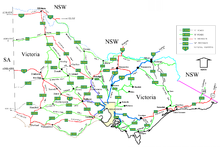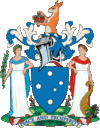- Department of Transport (Victoria)
-
Department of Transport
(DOT)Type Government Agency Predecessor Department of Infrastructure Founded 2008 Founder(s) Government of Victoria Headquarters Melbourne, Victoria, Australia Area served Victoria Key people Jim Betts (Secretary) Services Coordinate, integrate and regulate the State's transport system  Metro Trains Melbourne set 755M in Metro livery, part of the suburban train fleet in Melbourne. The Department of Transport is responsible for the overall planning, integration and delivery of train and other transport services in Victoria. Core public transport services are delivered by private operators under franchise agreements with the Director of Public Transport, a statutory office holder in DOT.
Metro Trains Melbourne set 755M in Metro livery, part of the suburban train fleet in Melbourne. The Department of Transport is responsible for the overall planning, integration and delivery of train and other transport services in Victoria. Core public transport services are delivered by private operators under franchise agreements with the Director of Public Transport, a statutory office holder in DOT.
 Recreational boating in Port Phillip Bay in Melbourne with the city in the background. Melbourne, the state capital, is home to more than seven in ten Victorians.
Recreational boating in Port Phillip Bay in Melbourne with the city in the background. Melbourne, the state capital, is home to more than seven in ten Victorians.
The Department of Transport or DOT is the central Government agency responsible for the coordination, integration and regulation of the transport system in the State of Victoria, Australia[1]. The Department's stated mission is "Building a safer, fairer and greener transport system for all Victorians to create a more prosperous and connected community."[2]
Contents
Ministerial portfolios
The Department of Transport supports three Ministerial portfolios, the Minister for Public Transport, the Minister for Roads and the Minister for Ports. It also supports one Parliamentary Secretary for Transport.
Agencies
DOT oversees and coordinates the activities of the state agencies responsible for the transport system in Victoria. These agencies can be divided into three main types - statutory offices, statutory authorities and independent transport safety agencies.
Together with DOT, the agencies provide, manage and regulate transport system activities in Victoria including -
- heavy and light rail systems including trains and trams
- roads systems and vehicles including cars, trucks and bicycles
- ports and waterways including commercial ships[3] and recreational vessels
- some air transport systems[4].
Statutory offices
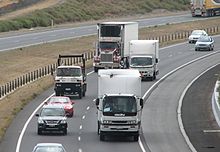 Cars and trucks on the Craigieburn Bypass north of Melbourne. Victoria has an extensive road network managed by VicRoads.
Cars and trucks on the Craigieburn Bypass north of Melbourne. Victoria has an extensive road network managed by VicRoads.
The statutory offices include -
- the Director of Public Transport
- the Transport Infrastructure Development Agent.
These agencies are part of the Department of Transport but each has a distinct statutory charter and powers[5].
Statutory authorities
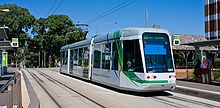 A Melbourne tram (C class tram number 3017) at the St Vincents Plaza stop in East Melbourne. Melbourne has the largest tram network of any city in the world and trams play a key role in the city's public transport system.
A Melbourne tram (C class tram number 3017) at the St Vincents Plaza stop in East Melbourne. Melbourne has the largest tram network of any city in the world and trams play a key role in the city's public transport system.
The statutory authorities[6] are -
- the Roads Corporation (VicRoads)
- Victorian Rail Track (VicTrack)
- V/Line Corporation (V/Line)
- Taxi Services Commission
- the Linking Melbourne Authority
- the Port of Melbourne Corporation
- the Victorian Regional Channels Authority
- the Transport Ticketing Authority
- the Regional Rail Link Authority.
These agencies are structurally separate from the Department of Transport[7].
Independent transport safety agencies
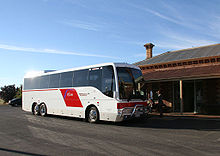 A coach in V/Line livery at Stawell station in regional Victoria. The coach is operated by Trotters under contract. Buses are a key part of Victoria's overall public transport system.
A coach in V/Line livery at Stawell station in regional Victoria. The coach is operated by Trotters under contract. Buses are a key part of Victoria's overall public transport system.
The independent transport safety agencies[8] are -
- the Director, Transport Safety (Transport Safety Victoria)
- the Chief Investigator, Transport Safety.
These agencies are part of the Department of Transport but are functionally independent and report to the relevant Ministers[9].
Governance
 Three container ships berthed at Swanson Dock West at the Port of Melbourne. The port is Australia's prime container port and is managed by the Port of Melbourne Corporation.
Three container ships berthed at Swanson Dock West at the Port of Melbourne. The port is Australia's prime container port and is managed by the Port of Melbourne Corporation.
The Department of Transport was established in 2008 and assumed the transport portfolio responsibilities of the former Department of Infrastructure. The activities and powers of the Department of Transport are governed by both the portfolios of its Ministers, the Minister for Public Transport, the Minister for Roads, the Minister for Ports and by the Transport Integration Act[10].
The Transport Integration Act provides that the objects of the Department are to -
-
- "(a) ensure that a transport system is provided consistent with the vision statement and the transport system objectives;
- (b) determine strategic policies which specify priorities for the transport system that address current and future challenges;
- (c) ensure in collaboration with transport bodies and other bodies that policies and plans for an integrated and sustainable transport ::system are developed, aligned and implemented."[11]
The Act provides that the "...principal function of the Department is to assist the Minister in the administration of this Act and other transport legislation..."[12] Other functions conferred on the Department include[13] -
- leading in the improvement of the transport system, including the development and construction of new transport infrastructure and services
- developing strategies, plans, programs and projects relating to the transport system
- undertaking operational activities including transport system operations, asset management and project management
- collecting transport data and undertaking research into the transport system
- leading in strategic policy, advice and legislation functions and coordinating policy and legislation advice relating to the transport system.
The Act also provides the Secretary of the Department with a range of specific powers including the power to enter into any agreement or contract[14].
Particular responsibilities
The Transport Integration Act imposes a range of responsibilities on the Department of Transport. These include -
- preparation of revisions to the Victorian Transport Plan[15]
- coordination of agencies' corporate plans across the transport portfolios[16]
- taking the lead in policy and legislation review[17] including projects such as the Transport Legislation Review
See also
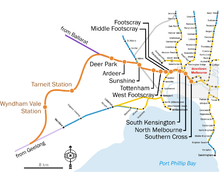 A Map of Melbourne's railway network with the projected Regional Rail Link. The project involves the construction of a rail link through the western suburbs of Melbourne from Southern Cross Station, running through Sunshine, Tarneit and meeting the Geelong Line at West Werribee. Completion is currently scheduled for late 2014.
A Map of Melbourne's railway network with the projected Regional Rail Link. The project involves the construction of a rail link through the western suburbs of Melbourne from Southern Cross Station, running through Sunshine, Tarneit and meeting the Geelong Line at West Werribee. Completion is currently scheduled for late 2014.
- Transport Integration Act
- Rail Safety Act
- Bus Safety Act
- Accident Towing Services Act
- Rail transport in Victoria
- Railways in Melbourne
- Road transport in Victoria
- Trams in Melbourne
- Transport Act 1983
- Transport (Compliance and Miscellaneous) Act 1983
- Tourist and Heritage Railways Act
References
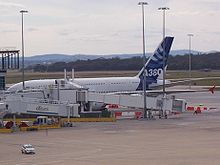 The A380 at Melbourne Airport. Melbourne Airport is the primary airport serving the city of Melbourne and the second busiest in Australia. The airport is 23 kilometres from the city centre.
The A380 at Melbourne Airport. Melbourne Airport is the primary airport serving the city of Melbourne and the second busiest in Australia. The airport is 23 kilometres from the city centre.
- ^ Transport Integration Act 2010, sections 32 and 33.
- ^ Department of Transport, Annual Report 2009-10, page 5.
- ^ Note, some shipping matters are controlled by the Commonwealth under legislation such as the Navigation Act 1912. Other matters are within the jurisdiction of states such as Victoria through Acts such as the Transport Integration Act and other statutes like the Marine Act 1988.
- ^ Note, many air transport regulation matters are controlled by the Commonwealth Government. The Transport Integration Act would apply, for example, to planning controls at some airports and in respect of transport connections to other airports by road and rail.
- ^ For information relating to the Director of Public Transport, see Division 1 of Part 5 of the Transport Integration Act 2010. The charter and powers of the Transport Infrastructure Development Agent are set out in Division 4 of Part 3 of the Transport Integration Act 2010.
- ^ See Parts 5 and 6, Transport Integration Act 2010.
- ^ The Act establishes these agencies as structurally separate bodies with their own legal personality. For example, section 81(4) of the Transport Integration Act 2010 establishes VicRoads as a "body corporate" which "may do and suffer all acts and things that a body corporate may by law do and suffer".
- ^ Part 7, Transport Integration Act 2010.
- ^ Section 194, Transport Integration Act 2010.
- ^ Transport Integration Act 2010, see in particular, Part 3 of the Act.
- ^ Section 32, Transport Integration Act 2010.
- ^ Section 33(1), Transport Integration Act 2010.
- ^ See section 33(2), Transport Integration Act 2010.
- ^ See sections 34-37, Transport Integration Act 2010.
- ^ Transport Integration Act 2010, section 63.
- ^ Transport Integration Act 2010, section 64.
- ^ Transport Integration Act 2010, section 33(2)(a) and (b).
External links
Victoria Topics History · Geology · State Government · State Parliament · State politics · Local government · Energy · Road transport · Rail transport · Sport · Education · Teaching
Regions Central Highlands · Gippsland · Grampians · The Mallee · Goulburn Valley · Melbourne · Port Phillip · Western Port · Mornington Peninsula · Yarra Valley · Bellarine · Sunraysia · Ovens and Murray · Australian Alps · Goldfields · Western District · Otways · WimmeraCities and towns Categories:- Government departments of Victoria (Australia)
Wikimedia Foundation. 2010.

